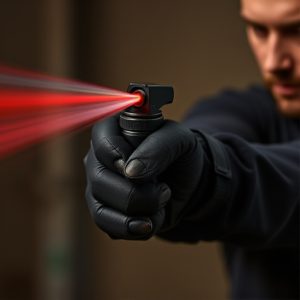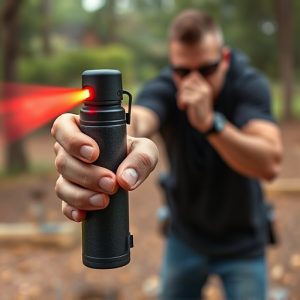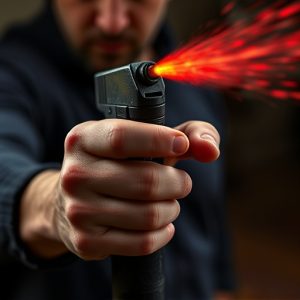Tactical Inflammatory Spray: Storage, Science, & Law Enforcement Integration
In hot climates, proper Hot Climate Pepper Spray Storage is crucial for maintaining the effectivenes…….
In hot climates, proper Hot Climate Pepper Spray Storage is crucial for maintaining the effectiveness of tactical inflammatory spray (pepper spray). High temperatures accelerate degradation of active ingredients, reducing potency. Optimal storage conditions include cool, dry areas with temperature control, away from direct sunlight and high humidity. Strategic deployment, regular maintenance checks, and adherence to safety protocols ensure the spray remains viable for extended periods, enhancing officer safety during crowd control scenarios. Understanding local regulations regarding pepper spray use is also essential.
“Tactical inflammatory spray systems have emerged as a powerful tool in law enforcement and personal defense. This comprehensive guide explores the intricacies of these advanced defense mechanisms. From understanding the science behind inflammatory sprays to navigating hot climate considerations for storage, we delve into effective integration strategies for law enforcement.
Additionally, we cover best practices, safety protocols, and legal implications, ensuring readers are equipped with knowledge on tactical inflammatory spray defense systems.”
- Understanding Tactical Inflammatory Spray: A Comprehensive Overview
- Hot Climate Considerations for Pepper Spray Storage and Deployment
- The Science Behind Inflammatory Sprays: Active Ingredients and Effectiveness
- Integrating Tactical Inflammatory Spray into Law Enforcement Strategies
- Best Practices for Training, Safety, and Legal Implications
Understanding Tactical Inflammatory Spray: A Comprehensive Overview
Tactical inflammatory spray, also known as pepper spray, is a non-lethal self-defense tool designed to disable and disorient an assailant temporarily. It works by causing irritation and burning sensations in the eyes, nose, throat, and respiratory system, making it difficult for the target to see, breathe, or fight back effectively. This type of spray is particularly useful in high-risk situations, such as police operations, military training, and personal safety in hot climate environments where traditional pepper spray storage methods need special consideration.
Storage of tactical inflammatory spray, especially in hot climates, requires a robust system to maintain its effectiveness and prevent premature activation. Hot weather can accelerate the degradation of the spray’s active ingredients, so proper containment and cooling mechanisms are essential. This includes using specialized containers designed for extreme temperatures and implementing coolants or temperature-controlled environments to ensure the spray remains viable for extended periods. Effective storage solutions also consider factors like humidity control and secure access to prevent unauthorized use or tampering.
Hot Climate Considerations for Pepper Spray Storage and Deployment
In hot climates, proper storage and deployment of pepper spray become even more critical to ensure effectiveness and safety. High temperatures can impact the integrity of the spray solution, potentially leading to degradation of its active ingredients over time. Therefore, storing pepper spray in temperature-controlled environments is essential to maintain potency. Cool, dry places within a building, such as a secure closet or basement, are ideal for hot climate storage.
During deployment, users must be mindful of the heat index and take precautions to minimize exposure. In extreme temperatures, pepper spray can become less efficient due to evaporation or drying out faster. It’s crucial to choose strategic deployment locations that offer some protection from direct sunlight and high winds. Additionally, regular maintenance checks should be conducted to ensure the integrity of the spray mechanism and its contents remain intact in challenging climatic conditions.
The Science Behind Inflammatory Sprays: Active Ingredients and Effectiveness
The science behind inflammatory sprays, such as those used in self-defense systems, lies in their active ingredients and how they interact with the human body, especially under hot climate conditions where storage is a key consideration. These sprays typically contain capsaicin, the primary compound found in chili peppers, which is responsible for the burning sensation it induces. When deployed, the spray irritates the eyes, nose, and respiratory tract, temporarily disabling an aggressor.
In hot climates, proper storage of these pepper sprays is essential to maintain their effectiveness. High temperatures can cause the active ingredients to degrade, reducing the potency of the spray. Therefore, storing them in cool, dry places, away from direct sunlight, ensures optimal performance when needed. This consideration is crucial for individuals living in regions with warm weather year-round, where access to fresh, potent self-defense tools is vital.
Integrating Tactical Inflammatory Spray into Law Enforcement Strategies
In recent years, law enforcement agencies have been increasingly incorporating tactical inflammatory spray into their defense strategies, especially in regions with hot climates where traditional pepper sprays might be less effective. This advanced tool offers a unique approach to crowd control and non-lethal force, proving invaluable in various challenging situations. Integrating this technology requires careful consideration of factors like temperature, humidity, and storage conditions, which can impact the potency and reliability of the spray.
Strategic planning is essential when adopting such systems, particularly in areas prone to extreme heat. Proper training ensures officers know when and how to deploy the spray effectively while minimizing risks associated with its use. Efficient storage solutions for hot climate pepper spray are also crucial, including temperature-controlled facilities and specialized containers designed to maintain optimal performance. This comprehensive approach enhances officer safety and empowers them to handle potentially violent encounters with a versatile and reliable non-lethal force option.
Best Practices for Training, Safety, and Legal Implications
When training with tactical inflammatory spray, especially in hot climates, proper storage and handling of pepper spray are paramount. Extreme temperatures can affect the potency and stability of the chemical agent, so storing pepper spray in a cool, dry place is crucial. This means avoiding direct sunlight, heat sources, and leaving containers exposed to excessive humidity. Consider investing in temperature-controlled storage facilities or insulated bags for transport, particularly during tactical deployments.
Safety protocols must be strictly observed to prevent accidental discharge and minimize the risk of over-spraying. Train users on de-escalation techniques, ensuring they understand when and how to deploy the spray responsibly. Additionally, provide comprehensive instruction on proper eye protection, as direct eye contact with the spray can cause severe irritation or even temporary blindness. Legal implications vary by jurisdiction, so familiarize yourself with local laws and regulations regarding pepper spray use, including restrictions on who can possess and carry such devices, as well as guidelines for their application in self-defense or law enforcement scenarios.
Tactical inflammatory spray systems, with their unique capabilities, offer a valuable addition to law enforcement strategies. By understanding the science behind these sprays and implementing best practices for training and safety, agencies can effectively harness their power while navigating legal implications. In hot climate environments, proper storage and deployment methods are crucial, ensuring these defensive tools remain reliable when every second counts. Integrating tactical inflammatory spray into existing protocols requires a comprehensive approach, addressing both operational needs and the specific challenges posed by varying weather conditions, ultimately enhancing officer safety and public protection.


